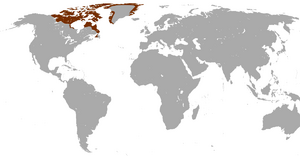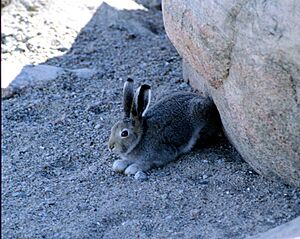Arctic hare facts for kids
Quick facts for kids Arctic hare |
|
|---|---|
 |
|
| Arctic hare in Nunavut, Canada | |
| Conservation status | |
| Scientific classification | |
| Subspecies | |
|
4, see text |
|
 |
|
| Arctic hare range |
The Arctic hare (Lepus arcticus) is a type of hare that lives in the Arctic tundra. It is very good at surviving in cold, icy places. Arctic hares have short ears and legs. They also have a small nose and a thick coat of fur. About 20% of their body is fat. This helps them stay warm.
These hares often dig holes in the ground. They also dig under the snow. This helps them keep warm and sleep safely. Arctic hares look a bit like rabbits. But hares have shorter ears. They also stand taller than rabbits. Unlike rabbits, hares can live well in very cold weather. They can sometimes travel in large groups. Dozens of hares might huddle together. But usually, they are found alone. They can run very fast, up to 60 kilometres per hour (40 mph).
Contents
Discovering the Arctic Hare
The Arctic hare was first described in 1819. An explorer named John Ross gave it its scientific name.
What Arctic Hares Look Like
The Arctic hare is one of the biggest lagomorphs. Lagomorphs are a group of animals. This group includes hares, rabbits, and pikas. Arctic hares are usually 43 to 70 cm (17 to 28 in) long. This measurement does not include their tail. Their tail is about 4.5 to 10 cm (1.8 to 3.9 in) long.
Most Arctic hares weigh between 2.5–5.5 kg (6–12 lb). Some very large ones can weigh up to 7 kg (15 lb).
Where Arctic Hares Live
Arctic hares live in the far northern parts of the world. You can find them in Greenland. They also live in the Canadian Arctic islands. This includes Ellesmere Island. They are found farther south in Labrador and Newfoundland.
These hares are very good at living in their cold home. They live in tundras and plateaus. They also live on treeless coasts. These areas have cold weather. They also have frozen precipitation like snow. Arctic hares can live from sea level up to 900 m (3,000 ft) high.
In Newfoundland and southern Labrador, Arctic hares change their fur color. They grow new fur, which is called moulting. In summer, their fur is brown or grey. In winter, it turns white. This color change helps them camouflage themselves. It helps them blend in with the changing environment. Other Arctic animals also change color. These include ermine and ptarmigan. However, Arctic hares in the far north of Canada stay white all year. This is because summer is very short there.
What Arctic Hares Eat
The Arctic hare is a herbivore. This means it only eats plants. It mainly eats woody plants. About 95% of their diet is arctic willow. They eat this plant all year round.
Arctic hares also eat other plants. These include saxifrage, crowberry, and dwarf willow. They can also eat lichens and mosses. Sometimes they eat flowers, leaves, twigs, and roots. They also eat mountain sorrel and seaweed. In summer, their diet is more varied. Recent studies show they eat many legumes. Legumes make up 70% of their summer diet. Arctic hares have even been seen eating meat sometimes. This includes fish. They also eat the stomach contents of dead caribou. They get water by eating snow.
How Arctic Hares Stay Warm
Arctic hares have special body features. These help them live in their extreme environment. They have a lower basal metabolic rate. This means their body uses less energy. But they can still keep their body temperature steady. It is about 38.9 degrees Celsius. This is similar to other hares. Their body shape helps them. They have a low surface area compared to their size. They also have thick fur for insulation.
Their lower metabolism helps them save energy. This is important in their cold home. It also helps them survive when food is scarce. Arctic hares move very efficiently. They also rest for long periods. They only forage for short times. This helps them save energy. It lets them live on less food.
The white fur of Arctic hares helps them in winter. It provides good camouflage. It also helps them in the daytime. Their white fur reflects sunlight. This stops them from getting too hot. In winter, Arctic hares keep warm by how they sit. They also dig or find shelter. When they rest, they curl up. They often stay in groups. But they do not huddle together tightly. If a hare is alone, it rests near large rocks. This protects it from the wind. It also hides them from predators. They also find shelter in snowdrifts. They can even dig their own burrows. These burrows can be up to 188 cm long.
Arctic hares can be smaller in winter than in summer. This is likely because there is less food. The food quality is also lower. Their body size can also be affected by temperature. In warmer areas of Greenland, hares were bigger. This might be because more food was available. In colder, higher areas, hares were smaller. This is also linked to food. Less snow and warmer temperatures can mean less food plants. This affects their body size.
Babies and Lifespan
Arctic hares usually breed in April or May. The mother is pregnant for 53 days. So, the baby hares are born in May, June, or July. Baby hares are called leverets. A mother can have up to eight babies. The average litter size is 5.4 babies.
The leverets stay near their mother. They stay until they can live on their own. Young Arctic hares are almost full-grown by late July. They can start having their own babies after one year old.
We don't know much about how long Arctic hares live. Some people think they live three to five years in the wild. Arctic hares do not do well in zoos. They usually live only about a year and a half in captivity.
Who Hunts Arctic Hares?
Many animals hunt Arctic hares. These are called predators. Known predators include the Arctic fox (Vulpes lagopus). The Red fox (Vulpes vulpes) also hunts them. Other predators are the Wolf (Canis lupus) and Lynx (Lynx canadensis). The Ermine (Mustela erminea) also preys on them. Birds like the Snowy owl (Bubo scandiacus) and Gyrfalcon (Falco rusticolus) hunt them. The Rough-legged hawk (Buteo lagopus) also preys on hares. Sometimes, even humans hunt them.
The Arctic wolf is a very good hunter of Arctic hares. Even young wolves can catch adult hares. Arctic foxes and ermines are smaller. They usually hunt young hares. Gyrfalcons carry hares to their nests. They often cut them in half first. Gyrfalcons use hare bones and feet to build their nests. This happens on Ellesmere Island, Nunavut. Peregrine falcons (Falco peregrinus) also hunt Arctic hares. This happens in the southern parts of the hares' range. Snowy owls mainly hunt young hares. The French name for the snowy owl means "hare-catcher."
Arctic hares can also have tiny creatures living on or inside them. These are called parasites. Some examples are tiny protozoans and worms. They can also have lice and fleas. Fleas are more common than worms.
Types of Arctic Hares
There are four different types, or subspecies, of Arctic hare:
- Lepus arcticus arcticus
- Lepus arcticus bangsii
- Lepus arcticus groenlandicus
- Lepus arcticus monstrabilis
Images for kids
See also
 In Spanish: Liebre ártica para niños
In Spanish: Liebre ártica para niños




